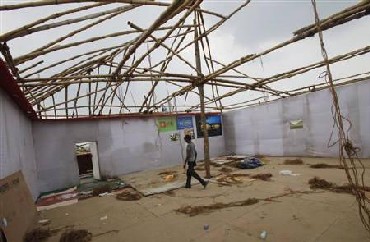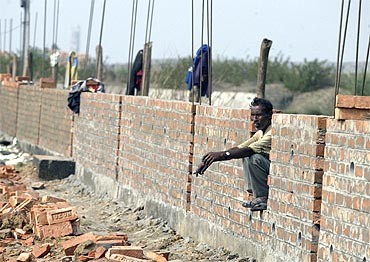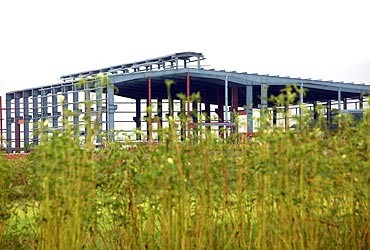 | « Back to article | Print this article |
How to safeguard oneself when buying a plot
Last week, the Greater Noida Industrial Development Authority reached a settlement with farmers in Patwari village.
The farmers were entitled to receive a higher compensation of Rs 550 per sq metre (over and above the Rs 850 per sq metre paid earlier) and 8 per cent developed land, 2 per cent more than what was promised to them earlier.
This agreement could become the basis for settlement with farmers in 10 other villages in Greater Noida that constitute an affordable housing hub called Noida Extension, where 250,000 apartments are being built at Rs 50,000 crore (Rs 500 billion).
Click NEXT to read more...
How to safeguard oneself when buying a plot
Case history: Around 2000 hectares of land was acquired by Greater Noida Industrial Development Authority (GNIDA). Farmers claimed that the land was acquired from them at Rs 400 per square metre and sold to builders at R10,000-11,000 per square metre per sqm.
Developers like Amrapali Group, Jaypee, 3C's and Supertech Ltd among others had announced their projects in the affordable category, attracting many buyers.
However, when the farmers came to know of this, they raised their voices. The court had ordered that the allotment should be cancelled, thus affecting at least 20 projects and at least 25,000 buyers.
This was followed by a spate of similar demands by emboldened farmers from at least 9-10 other villages of the region.
Click NEXT to read more...
How to safeguard oneself when buying a plot
This case is an important learning lesson for buyers. So, if you are looking at buying a property please note the following points:
Legal aspects: Before buying an apartment it is crucial to carefully examine all types of legal documents related to the building and the land. A buyer has the right to ask and verify the certificates and documents cleared by the respective agencies or boards with regard to the property.
Check whether the property has clear legal titles or not: The builder has to get clear title for the land or plot. This will ensure that the property is clear, marketable and it traces any charges or encumbrances created on the property and its present status.
It is required to examine the documents of ownership in Government revenue records. This will ascertain as to whether the property has clear and marketable title and to confirm whether it is affected by any encumbrances, rights or interests of any third party, the purchaser through his advocate/solicitor should investigate this matter before entering in to an agreement.
Click NEXT to read more...
How to safeguard oneself when buying a plot
Check if the developer has the right to transfer the property. He also needs to check if the transfer of property approvals from the statutory land development or planning authority or competent authority constituted under the Urban Land Ceiling and Regulation Act and the Income-Tax Act are provided.
Check whether the property is being built on agricultural land or not: Only a farmer is eligible to buy an agricultural land. Some builders use agricultural land for constructing building for residential or commercial purpose.
In such cases the builder needs to get the approval from the concerned authority to convert the agricultural land to that of a land for non-agricultural purpose. This permission is essential from the Collector, when the tenure of land is changed from agriculture to nonagricultural purpose for residence, commercial & industrial use.
Also the land revenue tax receipts need to be checked. These are issued to agriculturists by the village thasildar on payment of land revenue tax.
Click NEXT to read more...
How to safeguard oneself when buying a plot
Check for Adivasi land: Adivasi/tribal land can be traded only among recognised tribes. A transaction not within this ambit is not legal, unless taken over by the government for projects or as part of a land acquisition scheme.
Reservations/acquisitions: Check if the land has been reserved for a particular project, such as irrigation, or if the owner has been notified about an acquisition project by the state or central government.
Click NEXT to read more...
How to safeguard oneself when buying a plot
Check these documents:
7/12 document: This is the basic document of title and proof of rights. It includes the name of owner/tenant, land area, agricultural land survey, etc. It is available with the thasildar of the village.
Encumbrance certificate: This certifies that the land is not involved in a legal dispute. It can be obtained from the sub-registrar's office, where the deed for the land has been registered.
Release certificate: The seller could have pledged the land previously to take a loan. To ensure that all the loan payments have been made and that no amount is due, ask him to produce the release certificate from the bank.
Check all approvals: Check if the builder has all the approvals from the Municipal Corporation, Area Development Authorities, electricity boards, water supply and sewage boards.
Click NEXT to read more...
How to safeguard oneself when buying a plotHow to safeguard oneself when buying a plot
Need for a regulator
There is an urgent need to have accountability on the builders. Currently, the buyers are duped by unscrupulous developers and real estate agents. While, the buyer faces penalty in case he does not live up to his commitment, the developer gets away.
For example, there is no provision for penalty if the project is delayed; however, the exit clause for the buyer is always tough.
Further, in most situations, the buyer has no control over the land deal. If the builder sells a disputed property, the buyer does not get the money back.
This is unfair on the buyers who put their life savings to have a dream house. Hence a regulator is needed to protect the buyers.
Click NEXT to read more...
How to safeguard oneself when buying a plot
The proposed Real Estate Regulation Bill, which seeks to protect the interest of home buyers, is expected to be discussed in the monsoon session of the parliament CCI's recent slapping of a hefty fine on DLF for unfair and discriminatory practices against flat buyers will have an impact on the industry.
Further CCI probes, which brought a lot of top of the line builders under the scanner, could be an indicator of things to come and hopefully a regulatory body could be set up for the segment in the near future.
How a regulator can help:
A regulator is needed to check the veracity of the claims made in the advertisements published by the builders.
The regulator is needed to play a critical role in ensuring that the funds (advance money from the buyers) are used for the project only and not diverted, thus avoiding delays.
Further, the developer is needed to provide customers with access to information about the project they are about to invest in or have already invested. They also have to specify the exact carpet area and built up area. Customers need to be protected with a written agreement of sale before the customer pays any advance.
Further, a complaint redressal mechanism to resolve the disputes should also be included.
Click NEXT to read more...
How to safeguard oneself when buying a plot
Land Acquisition Bill
After witnessing the agitation of the farmers in Noida, the ministry of rural development is planning to replace the archaic Land Acquisition Bill of 1894.
It has come up with the draft of the National Land Acquisition and Rehabilitation and Resettlement Bill, 2011 and has placed it in the public domain till 31 August for comments.
If passed, it will replace the existing bill. The draft of the Land Acquisition Bill seeks to enhance compensation for landowners by six times in rural areas and two times in urban areas.
This in turn will make the land very expensive. Better compensation for farmers would mean more cost to the government or the builder coming up with a project on the land.
Finally, this cost would get passed on to the homebuyers.
Click NEXT to read more...
How to safeguard oneself when buying a plot
The issue of complexity of the processes also needs to be addressed. A builder has to take approvals and permissions from multiple agencies.
This takes around 1 to 4 years, which in turn increases the project cost. Hence, the first step is to make the process fast and simple. Also faster implementation of the new regulations is needed.
The final loser in an insufficiently regulated real estate market is the consumer. Their interests must be protected in order to safeguard the sector's performance and to ensure that the Indian real estate market remains attractive.
Powered by
BankBazaar.com is an online marketplace where you can instantly get loan rate quotes, compare and apply online for your personal loan, home loan and credit card needs from India's leading banks and NBFCs.
Copyright 2025 www.BankBazaar.com. All rights reserved.









